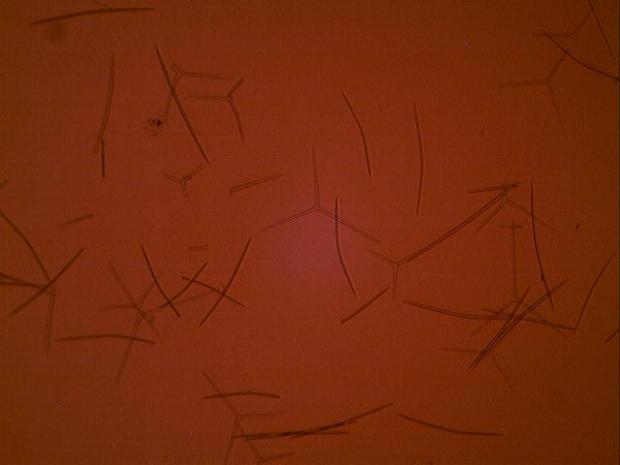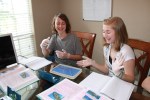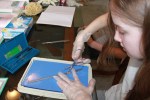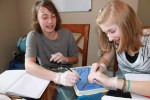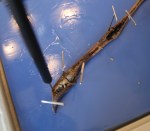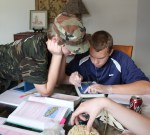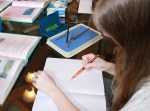Posts Tagged Apologia Biology Module 10
Apologia Biology: Module 11, “Invertebrates”
Posted by jlsgrant in Apologia Biology on February 5, 2011
Invertebrates….like sponges, and mollusks, and worms….oh my! And only two weeks to cover it all! Yikes! I wish we could stop and camp for awhile on my favorite invertebrate sea creatures, but I suppose the show must go on. Who knows, maybe Exploring Creation with Marine Science is somewhere in our future!
Symmetry – You’ve got to see this awesome post on Symmetry over at Applie’s Place! We are Not Created Equal! What a fun project! Thank you Applie!
Let’s start with Phylum Porifera, The Sponges. Check out this Filtering Barrel & Chimney Sponges video on You Tube to get a glimpse on how these creatures work as a filter.
Experiment 11.1 – Observation of a Sponge
We started by examining a sponge that I had purchased awhile back up in Tarpon Springs at the Sponge Docks. Once wet, it is actually very soft! I’m not sure what type of sponge this is, but please feel free to leave a comment if you do.
Before class, I took a small slice and prepared a microscope slide to observe under the microscope. One of the ways sponges are identified, is whether they have spicules and what type of spicules they possess. Because this type of sponge is very soft, we assumed that this sponge is a type that has spongin, not spicules. (See page 333 of your textbook.)
This image was taken at 40X.
Next we took a look at some spicules from a prepared slide. These are spicules from Grantia (Scypha) sponge at 40X:
We were able to locate needle and multipronged “jack” shapes in this image.
Next up is Phylum Cnidaria, with Hydra, Sea Anemone, Coral Polyp, and Jellyfish. Before we move ahead to the microscopic images, take a look at this video. God’s creation is so amazing! If you want to look at jellyfish in more detail look for the beautiful and harmless bioluminescent Comb Jellyfish (my favorite around Tampa Bay) or the deadly Irudkandji from the waters off the coast of Australia.
Watch these amazing light shows from the Bloodbelly Comb Jelly, courtesy of the Monterey Bay Aquarium.
Experiment 11.2 – Observation of a Hydra
The Hydra is a “typical” member of Phylum Cnidaria. We used the images below and Figure 11.5 (Page 338) to draw and label the as many structures as we could identify. (For a larger view, click the picture.)
Using the next images, taken at 100X, you should be able to locate the nematocysts, stingers, mesoglea, trigger and even the cells that secrete digestive enzymes:
Experiment 11.3 – Earthworm Dissection (Phylum Annelida)
Some people approach dissections with a bit of fear and trepidation. Not us though! We are real troopers! And it truly was very interesting to observe the worms last meal….dirt! I supposed we should have given them a proper burial and thanked them for their contribution to science, but we ran out of time and they were disrespectfully thrown into the trash! ;o
WARNING: Some photos may cause nausea, but hopefully not vomiting….proceed with caution! Just kidding; it’s only a worm!
Before we move on, I thought I’d share this short video by the Mystic Aquarium Institute for Exploration: Tube Worms living in the extreme environment of the world’s deepest oceans.
Experiment 11.4 – Observation of a Planarian
A Planarian is an example of an organism from phylum Platyhelmintes. We used the images below to sketch an identify the structures. Use the diagram in Figure 11.9, located on page 350 in your textbook, to help you identify the eyespots, branched intestines, pharynx, and mouth.
Phylum Nematoda: Roundworms
Members of this Phylum may be “out of sight”, but probably will not stay “out of mind” for long! Here’s a link to some short, but interesting video’s from the Monster’s Inside Me on Animal Planet.
This would be a wonderful time to take a trip to the beach, don’t you think? A day at the beach marine species field study is in order, right? And while we’re there, we should have a picnic, collect shells, and toss a frisby! Wouldn’t you agree?
Study Link: Flashcards & Games at Quizlet.com
Disclaimer: No compensation of any kind has been received in exchange for promoting the websites or TV shows mentioned in this blog post. Purely voluntary….yes, we have no trichinosis!
Apologia Biology: Module 10 – Ecology
Posted by jlsgrant in Apologia Biology on January 23, 2011
Wow! After Modules 1 – 9, Module 10 seems like a bit of a walk in the park, doesn’t it? If you’ve made it this far, congratulations! You are in the home stretch!!
For this co-op session, we planned to do Experiment 10.1, but there was no sun to help out, so that didn’t work out! 😦
Most of our time was spent creating a Florida Food Web, a little bit of a twist on the typical Food Web project. We used local species to create our web. The students were paired off and used “Florida’s Fabulous” series of books and the internet to gather information regarding their chosen group. They only recorded information related to the project; habitat, diet, and an interesting fact about each. Pictures and info cards were then attached to color coded paper (Green: Producers, Yellow: Primary Consumers, Blue: Secondary Consumers and Red: Tertiary Consumers. Once all this was completed, we built our web on a wall to visualize this complicated eco-system and learn how it is inter-connected. Each creature has its own role in providing energy to the whole. It one species fails, it affects the whole group. (Sorry I didn’t get a picture this time!)
Here’s a list of the producers and consumers we used:
Our Producers: Strawberry, Orange Tree, Grass & Weedy Vegetation
Our Consumers:
Insects: Aphid, Potter Wasp, Ladybird, Black Widow Spider
Reptile/Amphibian: Gopher Tortoise, Black Racer, Anole, Alligator
Fish: Tilapia, Catfish
Birds: Florida Scrub Jay, Mockingbird, Osprey, Bald Eagle, Black Vulture
Mammals: Pocket Gopher, Marsh Rabbit, Wild Hog, Bobcat
It took quite a bit of time to gather all the information and put it together, but it was a very interesting project. (Note: Some of our creatures fall into more than one group, depending on the food source du jour! So you may put them in a different group.) Another project I considered, was having each student make a Favorite Food Web, with the ingredients to their favorite meal shown in their personalized web.
Occassionally in nature, something strange and totally unexpected happens! Ask yourself, if a tertiary consumer eats another tertiary consumer, what does that make him?
Check out the #2 post on Mindful Ramblings for 2010!
Food Web:
Animal Planet once had a series called, Top 10 Odd Animal Couples. (Thanks to Applie for bringing this one to my attention. Be sure to check out her Apologia Biology section, for lots of good ideas. She also has pictures of their Everglades Food Web.)
Great photo gallery on MSNBC.com, “Unlikely Friends”
We did not have time to cover the other topics in the module at Co-Op, but here are couple other resources:
Water Cycle:
Southwest Florida Water Management District, referred to by most as “Swift Mud”, has a treasure trove of information on Florida’s water resources. While some a regional-specific, there are more generic resources available too and all of them are FREE!! There are educational materials for every level. Check your state for similar products.
Study Link: Flashcards & Games at Quizlet.com


